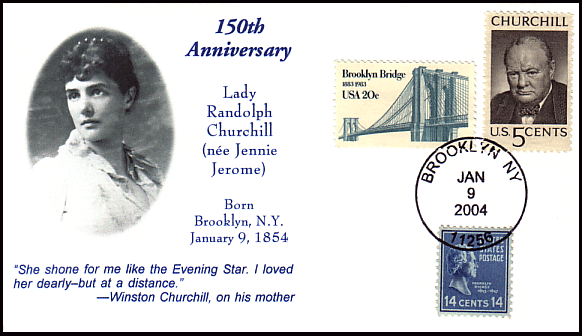
 | Lady Randolph Churchill, Winston's mother, was born in Brooklyn, N.Y. in 1854.
This cover marks the 150th anniversary of Jennie's birth, and depicts Jennie in
her 20s. It features a Churchill Memorial stamp, a Franklin Pierce "Prexie" stamp
(Pierce was president in 1854) and a Brooklyn Bridge Centennial stamp. (The bridge
did not yet exist in 1854, but its icon-like status makes it a natural for any
cover with a Brooklyn connection.) The Brooklyn NY postmark of January 9, 2004
completes the cover.
|
| A more mature Jennie appears in the cachet of this cover.
|
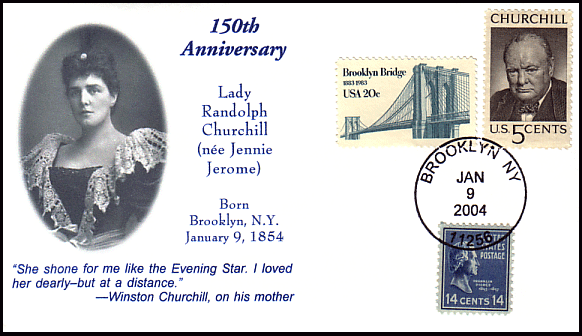
|
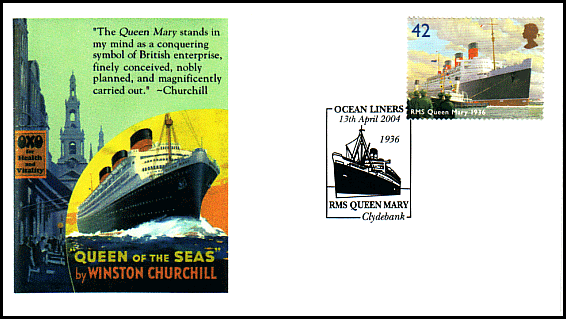 |
In celebration of the 2004 launch of the Queen Mary 2, Royal Mail issued a set of stamps featuring ocean liners. The original Queen Mary, launched in 1936, was the last of the great pre-war ships. During World War
II the Queen Mary carried more than 765,000 military personnel and ferried Winston Churchill to
conferences. In 1967 she became a floating hotel in Long Beach, California.
The cachet of this first day cover reproduces a 1936 cover of The Strand magazine, which contained Churchill's article about the then-new ship. The first
day of issue postmark from Clydebank also features the majestic vessel.
|
| When the Conservative Party lost the General Election of 1929, Churchill surrendered
his post as Chancellor of the Exchequer. It marked the beginning of what later
became known as Churchill's "Wilderness Years," a decade-long period during which
Churchill did not serve in a Cabinet-level position. Being excluded from government
affairs was frustrating to Churchill, but it also meant he was was not tainted
by the failure of appeasement when war with Germany finally came in 1939. In September
1939 he returned to office as First Lord of the Admiralty, and eight months later
he was Prime Minister.
This cover marks the 75th anniversary of 1929 election, postmarked in London on May 30, 2004. The 1974 Churchill Centenary stamp franking the cover shows Winston in the 1920s. |
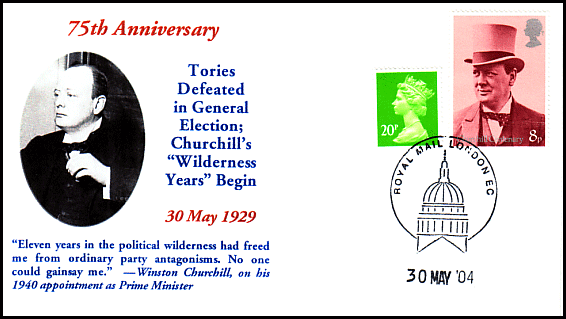 |
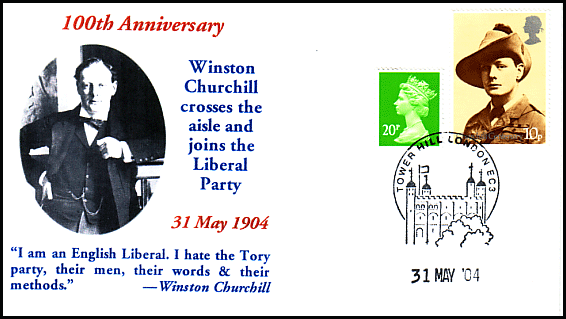 | When Churchill was elected to the House of Commons in 1900 it was as a member
of his father's Conservative Party. The Conservative Party, with its protectionist
trade policies, didn't suit the rebellious Churchill very long, and he became
gradually estranged from the Tories. On May 31, 1904, Churchill signaled the end
of his affiliation with the Conservatives by entering the House and taking his
seat among the Liberal benches. His ascendancy in the circles of power was soon
underway, as the Liberals gained a majority in the House the following year. Churchill
would remain a Liberal until the early 1920s.
This cover marks the 100th anniversary of Churchill's party switch, postmarked in London on May 31, 2004. |
| This cover marking the 60th anniversary of the D-Day invasion to liberate Europe
features Churchill's words to the House of Commons on June 6, 1944. It is franked
with a 1994 D-Day stamp and a 1974 Churchill Centenary stamp, and received a special
D-Day anniversary postmark from Portsmouth. (I also prepared companion covers from the U.S. and Canada.)
|
 |
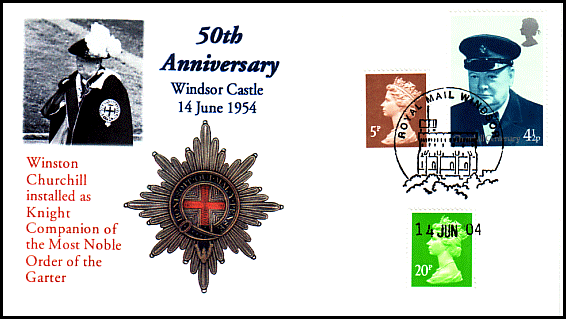 | Churchill was knighted by Queen Elizabeth II in April 1953 (see the 2003 page for that cover). His formal installation as a Knight of the Garter took place
more than a year later, at a ceremony at Windsor Castle. The cachet features a
photo of Churchill taken on the day of his installation, and was postmarked at
Windsor on June 14, 2004, the 50th anniversary of the ceremony.
|
| After retiring as Prime Minister in 1955, Churchill remained an MP, winning re-election
as member for Woodford in 1959. Age and increasing infirmities, however, limited
his attendance at the House of Commons during the 1960s, and in 1964 Churchill
reluctantly decided not to run again for re-election. His final visit to the House
was on July 27, 1964, during which the House considered a resolution expressing
its gratitude to Sir Winston for his more than 60 years of service.
This cover was postmarked in London on July 27, 2004 with a special "Rule Britannia!" postmark in use for just that day. |
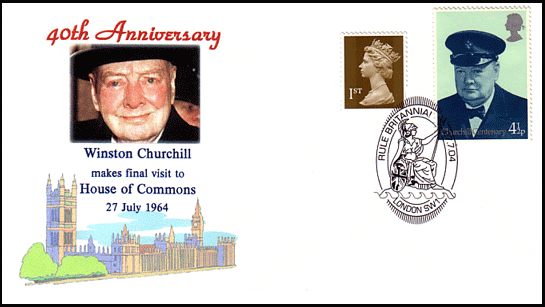 |
 | The Battle of Blenheim was fought on Aug. 13, 1704, at the village of Blenheim,
near Höchstädt, Bavaria. Responding to appeals from Vienna, which was threatened
by French and Bavarian forces, the English commander, John Churchill, Duke of
Marlborough, marched his army from the Netherlands to Bavaria and joined forces
with the Austrian general, Prince Eugene of Savoy. At Blenheim their combined
army overwhelmed the Franco-Bavarian forces. For the first time in two generations
the French suffered a crushing defeat, and the results were immediate and far-reaching.
Bavaria was conquered and Vienna saved. The territorial ambitions of Louis XIV
beyond the Rhine were checked, and France was placed on the defensive.
This cover marks the 300th anniversary of the great battle, postmarked on the anniversary date in Oxford, near Marlborough's Blenheim Palace. Many consider Marlborough, His Life and Times to be Churchill's finest literary work. |
| During a lengthy speech in the House of Commons on August 20, 1940, Prime Minister
Churchill paid tribute "to the British airmen who, undaunted by odds, unwearied
in their constant challenge and mortal danger, are turning the tide of the world
war by their prowess and by their devotion. Never in the field of human conflict
was so much owed by so many to so few." Battle of Britain Day 2004 saw the use
of this special postmark "remembering the few."
|
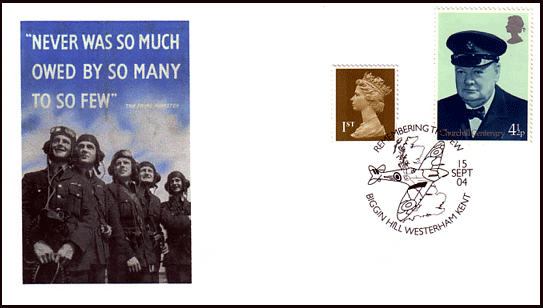 |
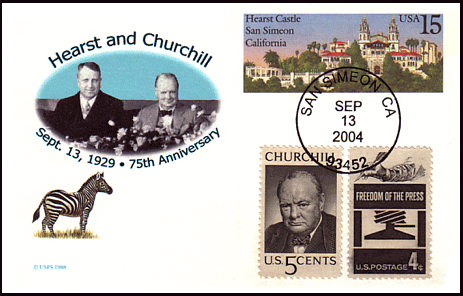 | After
a 28 year absence, Churchill returned to North America in 1929. Among
the many noteworthy individuals with whom Churchill spent time was
controversial publisher William Randolph Hearst. Churchill and his
party were Hearst's guests at his opulent estate at San Simeon,
California, known today simply as Hearst Castle. This Hearst Castle
postal card, with a Churchill stamp and a Freedom of the Press stamp,
was postmarked at San Simeon on the 75th anniversary of Churchill's
visit.
|
| Another Hearst Castle cover, this one with a Churchill stamp and a California
stamp issued for the 150th anniversary of statehood in 2000.
|
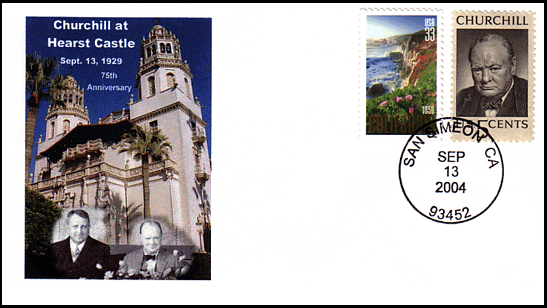 |
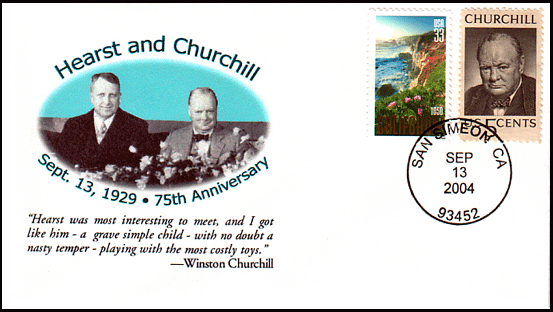 | Yet another Hearst Castle cover. Churchill wrote to his wife: "Hearst was most
interesting to meet, & I got to like him - a grave simple child - with no
doubt a nasty temper - playing with the most costly toys. A vast income always
overspent: Ceaseless building & collecting not v[er]y discriminatingly works
of art: two magnificent establishments, two charming wives; complete indifference
to public opinion, a strong liberal & democratic outlook, a 15 million daily
circulation, oriental hospitalities, extreme personal courtesy (to us at any rate)
& the appearance of a Quaker elder - or perhaps better Mormon elder."
|
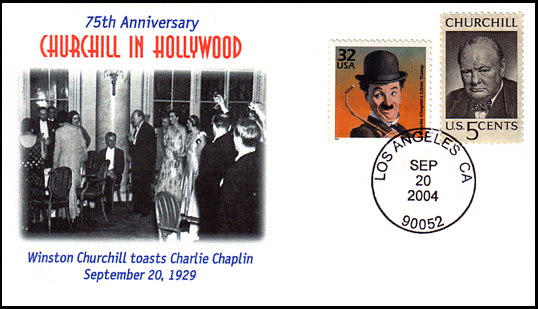 | Another luminary with whom Churchill associated was actor/director Charlie Chaplin.
On the evening of Friday, September 20, 1929, Churchill and his entourage attended
a lavish dinner party with Chaplin and other Hollywood stars, including Pola Negri, Harold Lloyd, Billie
Dove, Bebe
Daniels, and Wallace
Beery, among others.
|
| Churchill, in a letter to his wife, discusses Chaplin: "We made g[rea]t friends
with Charlie Chaplin. You c[oul]d not help liking him. The boys were fascinated
by him. He is a marvellous comedian - bolshy in politics - delightful in conversation.
He acted his new film [City Lights] for us in a wonderful way. It is to be his g[rea]t attempt to prove that the
silent drama or pantomime is superior to the new talkies. Certainly if pathos
& wit still count for anything it is out to win an easy victory."
This cover features a different Chaplin stamp, with a caricature by the famous Al Hirschfeld. Another cover with a different combination of stamps is here. |
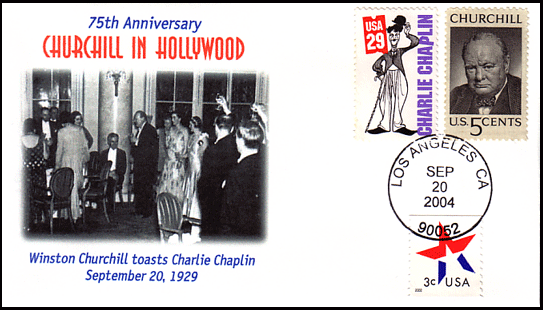 |
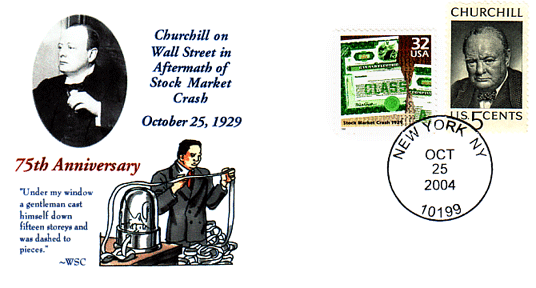 | Winston Churchill had the fateful distinction of being at the center of many
of history's most important events. So it comes as no surprise to learn that Churchill
was on Wall Street during the Crash of 1929. Black Thursday was October 24, and
the next day Churchill was walking down Wall Street: "A perfect stranger who recognized
me invited me to enter the [stock exchange] gallery. I expected to see pandemonium;
but the spectacle that met my eyes was one of surprising calm and orderliness
. . ." Traders were "offering each other enormous blocks of securities at a third
of their old prices and half their present value . . . finding no one strong enough
to pick up the sure fortunes they were compelled to offer."
|
| Churchill also witnessed the tragic consequences of the Crash. "Under my very
window a gentleman cast himself down fifteen storeys and was dashed to pieces,
causing a wild commotion and the arrival of the fire brigade. Quite a number of
persons seem to have overbalanced themselves by accident in the same sort of way."
This cover features a Churchill stamp, a Herbert Hoover stamp, and a New York Stock Exchange bicentennial stamp. |
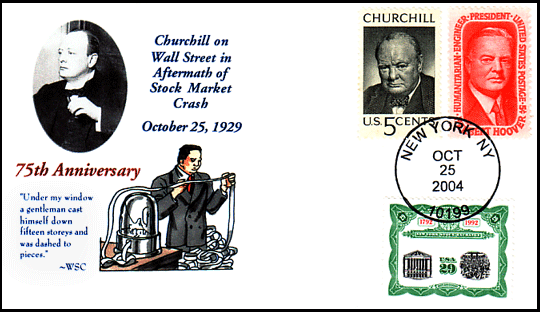 |
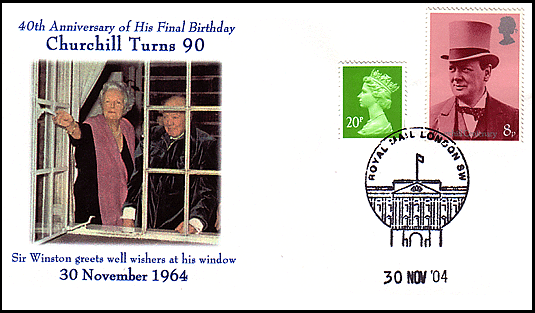 | Sir Winston's final birthday celebration in 1964 saw him become a nonagenerian.
Churchill, quite frail by this time, celebrated at his London home with family.
As his daughter Mary later wrote, "The house glowed with candlelight and flowers,
and we were united yet one more time in drinking first to Winston's health and
then Clementine's. But this birthday evening had for us all a poignant quality--he
was so fragile now, often so remote. And although he beamed at us as we all gathered
round him, and one felt he was glad to have us there--in our hearts we knew the
end could not be far off."
On the evenings of November 29 and 30, crowds gathered in front of the Churchill residence to sing 'Happy Birthday.' Sir Winston came to the window each night and greeted the crowds, flashing his trademark V-sign. |
